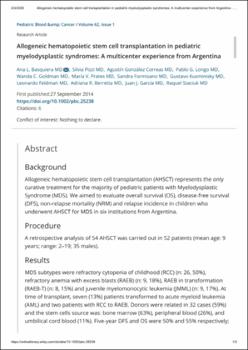| dc.description.abstract | BACKGROUND:
Allogeneic hematopoietic stem cell transplantation (AHSCT) represents the only curative treatment for the majority of pediatric patients with Myelodysplastic Syndrome (MDS). We aimed to evaluate overall survival (OS), disease-free survival (DFS), non-relapse mortality (NRM) and relapse incidence in children who underwent AHSCT for MDS in six institutions from Argentina.
PROCEDURE:
A retrospective analysis of 54 AHSCT was carried out in 52 patients (mean age: 9 years; range: 2-19; 35 males).
RESULTS:
MDS subtypes were refractory cytopenia of childhood (RCC) (n: 26, 50%), refractory anemia with excess blasts (RAEB) (n: 9, 18%), RAEB in transformation (RAEB-T) (n: 8, 15%) and juvenile myelomonocytic leukemia (JMML) (n: 9, 17%). At time of transplant, seven (13%) patients transformed to acute myeloid leukemia (AML) and two patients with RCC to RAEB. Donors were related in 32 cases (59%) and the stem cells source was: bone marrow (63%), peripheral blood (26%), and umbilical cord blood (11%). Five-year DFS and OS were 50% and 55% respectively; and for patients with JMML, 57% and 67% respectively. Cumulative incidence of NRM and relapse were 27% and 21% respectively. In the multivariate analysis, umbilical cord blood (HR 4.07; P = 0.025) and age ≥ 9 years at transplantation (HR 3.28; P = 0.017) were associated with lower OS; age and graft-versus-host disease (GVHD) had a higher NRM.
CONCLUSIONS:
In our series, more than half of the patients achieved long term OS with AHSCT. Less toxic conditioning regimens or more intensive GVHD prophylaxis could lead to better results in some children. | en_US |


